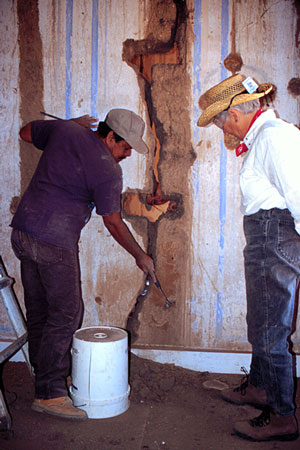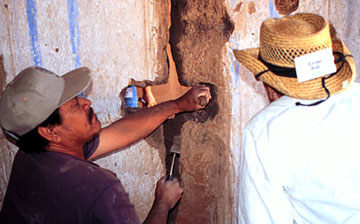Inside Kentucky Camp - Passport in Time
Main menu:
Previous Projects > States A-F
Inside Kentucky Camp
Coronado National Forest, Arizona, 1999
by Mary Farrell, Forest Archaeologist
Hailing from Tucson and Tombstone, from southern Arizona and northern Arizona, from Texas, New Mexico, and California, from as far away as Idaho, Washington, Oregon, New York, and Vermont, and even from Hermosillo, Mexico, over 50 volunteers converged on Kentucky Camp between April 19 and 24 for our first international PIT project. This was also our largest project to date, and even the most extroverted folks may have felt slight trepidations when they first saw the sea of tents and vehicles at our normally quiet site.
 But productivity arose from the pandemonium, in large part thanks to the Friends of Kentucky Camp (FKC) who served as project leaders and logistics coordinators. Each day the volunteers organized themselves into small work groups. Some helped build forms, pour cement, and install a new vault toilet and water line. Adobe workers patched cabin exteriors, capped the eroded barn ruins, and added a sacrificial coat to a severely wind-blasted cabin wall.
But productivity arose from the pandemonium, in large part thanks to the Friends of Kentucky Camp (FKC) who served as project leaders and logistics coordinators. Each day the volunteers organized themselves into small work groups. Some helped build forms, pour cement, and install a new vault toilet and water line. Adobe workers patched cabin exteriors, capped the eroded barn ruins, and added a sacrificial coat to a severely wind-blasted cabin wall.Wielding picks, shovels, and pulaskis, trailbuilders constructed a new interpretive route to the Boston Gulch hydraulic pits and repaired sections of the Arizona Trail. One archaeological team analyzed artifact patterns and completed mapping at the Boston Gulch miners’ camp, another investigated a small trash dump found in the backhoe trench excavated for the new water line, and a third solved the mystery of the underground cistern and drainage system.
 Brave wood workers ripped up the rotted boards in the office hall, enduring dust, splinters, and hanta virus hazards to replace disintegrated joists and rebuild the floor. Others cleaned, sanded, and patched mop boards, leveled crooked windows, repaired a leaky roof, created a new photo exhibit, and worked on grant proposals. For the future cabin rental, we have two beautiful new bunk beds and the beginning of a hand-braided rag rug. The logistics crew made sure we had tools, solar showers, slide projectors and screens, tables and chairs, first aid expertise, and food and beverages. Our camera crews caught most everything in still photographs and on videotape.
Brave wood workers ripped up the rotted boards in the office hall, enduring dust, splinters, and hanta virus hazards to replace disintegrated joists and rebuild the floor. Others cleaned, sanded, and patched mop boards, leveled crooked windows, repaired a leaky roof, created a new photo exhibit, and worked on grant proposals. For the future cabin rental, we have two beautiful new bunk beds and the beginning of a hand-braided rag rug. The logistics crew made sure we had tools, solar showers, slide projectors and screens, tables and chairs, first aid expertise, and food and beverages. Our camera crews caught most everything in still photographs and on videotape.Our visiting experts from the Instituto Nacional de Antropología e Historia focused on three main tasks: repairing the fine interior plaster of Cabin C; cleaning, consolidating, and repairing the fine plaster and paint work in the office; and fixing structural problems. But they also found time to provide advice and recommendations, to do architectural drawings and sketches, and to give presentations about different phases of restoration work. The Arizona Daily Star featured two stories on the project, and the new Warner Brothers television station WB58 produced a short segment that has aired several times.
A recent special issue of FKC’s Kentucky Camp Chronicle was dedicated to the PIT and FKC volunteers, who not only accomplished a tremendous amount of work, but also miraculously maintained their enthusiasm and energy despite noisy winds that made a good night’s sleep impossible.